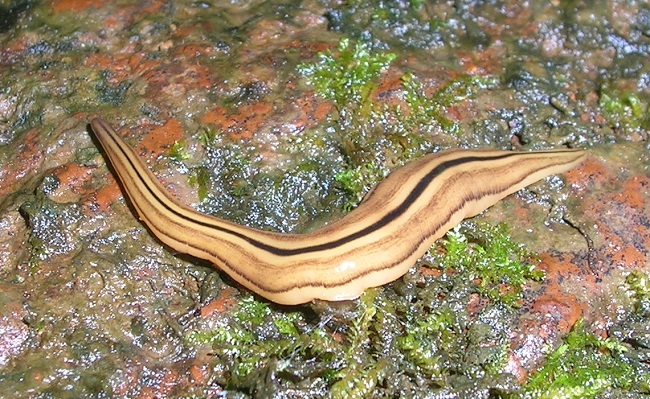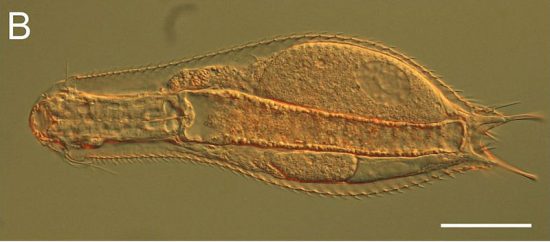Acoelomate Definition
An acoelomate is an animal which lack a coelom, or formal body cavity. True body cavities form only in multicellular organisms with true tissues. Within this group, the eumetazoa, there are the organisms like coral and jellyfish, which have only 2 basic tissues. The triploblastic eumetazoa have 3 tissue types.
An acoelomate is the simplest form of animals which have 3 true tissues. These tissue are the endoderm, mesoderm, and ectoderm, in that order from inside to out. In an acoelomate, these tissues touch back-to-back, without any space in between. The organs form within it, and are surrounded by the mesoderm. The ectoderm is the skin, while endoderm forms the digestive tract.
While pseudocoelomates and coelomates have a cavity between these tissues, an acoelomate does not. An acoelomate, such as in the examples below, is solid except for the digestive tract itself.
Examples of an Acoelomate
Platyhelminthes
The phylum Platyhelminthes, otherwise known as the flatworms, is a large and diverse phylum, containing many an acoelomate flatworm. Flatworms are parasitic or free-living, unsegmented worms. They have an incomplete gut, with one opening through which food is both ingested and excreted. However, they have a high degree of cephalization, meaning they have a centralized nervous system toward their head. Below is an example of a large turbellarian, a type of free-living flatworm.

These acoelomate creatures also take on a number of parasitic forms, such as flukes and tapeworms. Both of these parasitic forms live within the gut of their host, feeding on whatever the host feeds on. Regardless of whether the acoelomate is free-living or parasitic, it exchanges gas the same way. Flatworms are typically so thin that gas-exchange can be accomplished across the skin, without the need for lungs, gills, or other complex organs.
Entoprocta
Entoprocts are tiny, filter feeding organisms found in fresh and salt water. They are usually sessile, and are usually acoelomate. Like the flatworms, they lack a coelom, but have 3 distinct basic tissues. Unlike the flatworms, the entoprocts have a complete gut, which is “U” shaped. This allows one side of their body to attach to the substrate, while the other side filters food from the water column.
Gnathostomulida
Like the flatworms, the Gnathostomulida are a phylum of worm-like animals, which live mostly in marine environments. The word “gnatho” refers to “jaws” as these tiny little creatures have some of the tiniest jaws in the animal kingdom. These tiny jaws can be seen in the image below, near the head of the creature. Like the other acoelomate phyla, these animals have no body cavity. The space between their skin and intestines is packed with muscles and filler cells. This make a circulatory system, heart, and lungs unnecessary. All that can be seen in the image below is the jaw and intestine of the animal.

Gastrotricha
Like some other phyla not mentioned here, the Gastrotricha are supposedly acoelomate. However, this may simply be because the gastrotricha are hard to study. These tiny animals (most are only 1 mm), are commonly thought to be related to other, non-acoelomate groups. For this reason, some scientists don’t always classify them as acoelomates. However, any body cavity they have is filled with mesenchyme cells and muscle, effectively making them acoelomates.
The gastrotricha symbolize a number of problems scientists have with identifying and classifying organisms. First off, the gastrotricha are microscopic. The largest is only 3 mm in length. Look at one in the image below.

It is hard for scientists to tell exactly what is happening on the inside of the organism. Is there a cavity, or can you just see right through the layers of skin to the other side? While the gastrotricha is recognized by its peculiar mouth and spines, its acoelomate condition is often debated.
Why does being Acoelomate Matter?
In classifying animals, scientists tend to use a variety of common features to identify which groups are most closely related. While DNA evidence has added vast knowledge to this field, it is also only one piece of the puzzle. The development of a body cavity is one characteristic which scientists have tracked for ages as a standard delineator between different phyla.
As the Gastrotricha and other phyla show, this is not always easy. While it is easy to distinguish a coelom in a large animal, it may be nearly impossible in a microscopic animal. Thus, an acoelomate may look exactly the same as a microscopic coelomate, because the actual body cavity is so small. Further, animals like those in the Gastrotricha did not stop evolving millions of years ago. While they may be acoelomate, they have also developed many advanced features like organs, spines, and complicated intestines.
Sometimes, people tend to associate an acoelomate with primitive evolution, and somehow think that a coelom is the more “advanced” form. Having or not having a body cavity are simple different strategies for surviving on this world. Flatworms have been around far longer than humans, and will probably outlive us too. The acoelomate body plan is simple, yet very effective.
Quiz
1. Select the sentence which properly describes an acoelomate:
A. An animal with three body tissues
B. An animal with three body tissues, but no body cavity
C. An animal without a body cavity
2. An earthworm is part of the phylum Annelida. Earthworms have a true coelom. Flatworms do not. Which organism is more evolved?
A. The flatworm
B. The earthworm
C. Neither
3. What is one reason it might be a benefit to HAVE body cavities?
A. You can store food
B. Protects your organs from impacts
C. No good reasons
